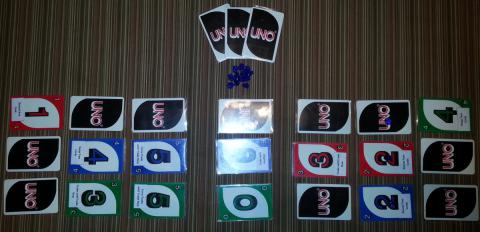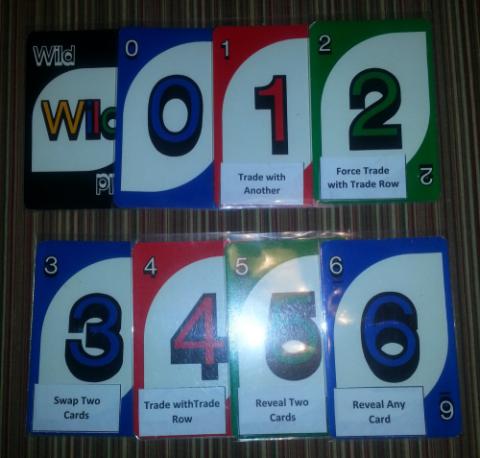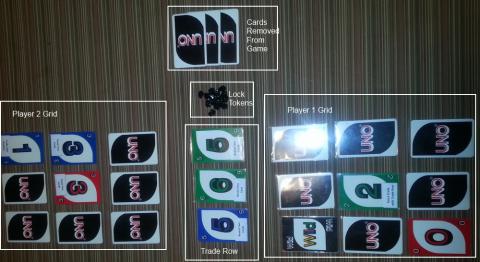Game Makeover: Nines Micro – Round 1
Design Workbench
Design Objective
The goal of going micro is to drop the game down to its bare essentials in components and rules while keeping the essence of the game. I’ll start by dropping the card count down (assuming 2 players) to:
- 18 = Minimum for the player grids.
- + 3 = A trade row of 3-5 cards (depending on player count, maybe n+1)
- + 3 = A few cards that are taken out of the game to hide some information; hopefully, making it more than a puzzle and keep it interesting.
- = 24 Total cards.
Now let’s see how that meshes with the card characteristics:
- Every card has a point value, but the 0 and “Treasure”/Wild (-3) cards stay in the game.
- All point cards 1-x have an action.
- Options for Point Value – Action card combination.
- Coincident Value System: Action ranges in scope/value coincident with Point Value. Lowest point cards, highest value, have the highest value actions. Since this game has negative scoring, I will start with this option.
- Counter Value System: Action ranges in scope/value counter to Point Value. . Lowest point cards, highest value, have the lowest value actions. This is the likely eventual outcome since it balances the two values a card may have so that all cards are attractive – there are no cards that are a bad draw.
- Some other pattern or arrangement based on playtesting.
- Options for Point Value – Action card combination.
- Potentially: Cards can change orientation (square cards or tiles).
- This allows actions that change card orientation.
- This may change the actual value of the card or just how it is scored.
- Keeping this in mind, but not implementing at the outset.
That allows for:
- Point cards 0 – 6 in 3 colors. (21 cards)
- 3 Wild cards.
- = 24 Total cards.
Setup
- Deal 3 cards to form a “Trade Row.”
- Players take turns drawing one card from the “Trade Row” and replacing it from the stock to a total of 3 cards drawn.
- Deal 6 more cards face down to each player.
- Players arrange their cards into a 3 x 3 grid however they want.
- The 3 cards forming the Trade Row remain between the players.
- The remaining 3 cards in the stock are set aside without looking at them. They are out of the game for this round.
- Optionally, about 12 “lock tokens” are placed near the trade row.
Play
The basic rules with some options to try are:
- Each player in turn does his choice of one of the following actions:
- Reveal a card.
- Conceal a card to use its action. (See available actions below.)
- Lock a card, a row, or a column. (Or a diagonal?) Your choice.
- This can be designated by turning the card sideways or setting a lock token on the card(s). Since card orientation might be introduced as important later, I am using the lock tokens.
- An option to try later: Unlock a card, a row, or a column. (Or a diagonal?) Your choice.
- The start player switches to the last player in each turn.
- This provides the opportunity to play action combos that compound and/or protect the results.
- This may effectively reduce this to a 2 Player game only.
Additional rules:
- Locked cards cannot be manipulated by either player.
- However, concealed cards that are locked will be revealed and scored at the end of the round.
- Wilds – Score Options: (in order of preference and testing)
- Option 1: (but may be too powerful)
- Count as any color/suit.
- Option 2:
- Count as any number only.
- Option 3:
- Count as -3. (Like the Treasure cards in the base game).
- Option 1: (but may be too powerful)
Actions
The initial Action descriptions and Point – Action combinations are below. I am starting with basic actions, but there can be further changes (e.g., a Reveal Action may become a Reveal or Peek Action). The rank of Actions is estimated and may prove to be different based on playtesting – due to unexpected uses and possible combos.
|
Points |
Action on Card |
Player Affected |
Basic Type |
|
6 |
Reveal a card in any player’s grid. |
Either (+/-) |
Reveal |
|
5 |
Reveal two cards in your own grid. |
Self (+) |
Reveal |
|
4 |
Trade a card in your grid with the Trade Row. Initially, the card must be revealed, but also try concealed cards and leave them at their current state (revealed/concealed) in the Trade Row. |
Self (+) |
Trade |
|
3 |
Swap any two cards in your grid. |
Self (+) |
Move |
|
2 |
Force another player to trade a card with their choice of card from the Trade Row. Initially, the player forcing the trade can designate the card to trade, but also try allowing the affected player to choose. |
Other (-) |
Trade |
|
1 |
Trade a designated card with another player. The player taking the Action gets to select both cards. |
Self (+) Other (-) |
Trade |
|
0 |
At this point I am keeping this action open. It is also worthwhile trying to keep these cards face up, by not having an action. There may also be other actions that are worth trying out. |
|
|
There is still room for another action or two to replace one or more of these. As in the original Nines Makeover, I want to look for moments in playtesting when the player thinks, “I wish I could…” Alternately, if the cards are symmetrical, new actions can be related to changing the orientation of any card in any grid. In the back of my mind I see a possible future for this design where the values of the cards are represented by patterns rather than numbers and a row of the same cards with the same orientation is absolutely obvious and pleasing.
End of Game
- Once one player has revealed all cards in their grid, their round is finished.
- The other player(s) gets to take one more turn.
- The other player(s) reveals any concealed cards.
- The round is scored.
- The player with the lowest score wins. (Still using low scoring model for now).
Glossary
Since I have scrapped the theme, there is less to report here, but I also want to change the definition of “Set” to be consistent with typical card games.
- Action: The action described on a card that can be enabled/activated by concealing the card.
- Coincident Value (System): Lowest point cards, highest value, have the highest value actions.
- Collection: Cards in a row or column (and optionally diagonal) that are all the same color.
- Counter Value (System): Lowest point cards, highest value, have the lowest value actions.
- Grid: The 3 x 3 grid of cards in front of each player that acts as their hand.
- Lock(ed): A card that is prohibited from any further action by any player.
- Set: Cards in a row or column (and optionally diagonal) that are all the same number.
- Single: A card that is not part of any Set.
- Trade Row: Three cards between the players that are used initially to draw a starting hand and that remain throughout the game to be traded when an appropriate Action is used.
Scoring
- Wild Cards: Wilds count as any number or color desired when scoring any set or collection.
- Sets: Cards in a set score 0. A set is any row or column (and optionally diagonal) all of the same number.
- Singles: Cards not in any set score their point value (0 – 6).
- Collections: Any collection of all the same color in any row or column (and optionally diagonal) scores -3.
- Locks: Locks have no impact on scoring. (I don’t anticipate this changing, but have them listed here in case there is cause to change this.)
Playtest
Prototype
Here is a great use for Uno cards – one might say a better use for Uno cards. I separated out cards from an Uno deck that match the stats for this game (3 Wild and 1 each of 0 – 6 in 3 colors). I printed stickers that describe the actions for each card and affixed them to the appropriate cards. I added 15 black tokens to represent locks to complete the components. As mentioned earlier, the lock function can be further simplified by turning a card sideways to signify a lock, but I am keeping card orientation open for other possibilities for now and don’t want to train my brain that it strictly means locking a card.
Playing
After the first few plays, it is obvious that this microsizing has turned a relatively simple game into a brain-burner. (The original Nines game could be described as very simple). With the various scoring options, the plan of attack can be very mathy. However, there is still the option of playing conservatively and only using obvious actions, so the game may still be very approachable.
The Draft
Depending on the cards that are turned for the Trade Row, the initial draft is fairly straight forward. There can be some decisions based on:
- Color vs. Point Value: Pick a card with a matching color to one(s) already drawn instead of a lower number that does not match.
- Action: Pick an action that the player can see as useful based on other actions already drawn or generally useful.
Although the typical decision is still very simple, having any decision and a better chance of getting something useful mitigates the luck of the draw.
Grid Play
Depending on what cards are in the grid at the outset, the first few turns might be fairly straightforward; reveal a few key cards in your own grid to determine the best strategy, but they can also be very tricky and highly interactive; go after the opponent’s low point cards to 1) get a lower score and 2) take away their ability to get at your cards.
Switching the first player each turn provides the opportunity for combos which make planning moves more complex and interesting.
More plays and introducing some of the options discussed here (e.g., optional point-action cards, use of diagonals, peeking instead of revealing, exchanging concealed cards with the Trade Row, etc.) are necessary to do a deeper analysis.
Working It Out
So have I made any progress with these changes?
Unmitigated Randomness
- The Trade Row provides some mitigation.
- The Actions that allow trades with the opponent and the Trade Row and swapping cards in the grid provide mitigation.
Few Decisions
- The number of decisions for a player that wants to do the math have jumped up significantly.
Bland
- At this point this game is an abstract, so there is nothing thematically to make it more interesting.
- The complexity and opportunity for combos have made it technically very interesting.
Multiplayer Solitaire
- There is definitely much more player interaction and interdependence (Actions that affect the Trade Row or the availability of desirable cards in the opponent’s grid.)
- It is hard to figure what the opponent will do so it is not like playing against an AI, but more playtesting is necessary to see if dominant strategies emerge.
Game Length
- The limited number of cards and the almost automatic progress toward an end make this a bit of a race.
Redundancy
- There is little wasted action in the game now, so there aren’t repetitive, meaningless turns.
Wasted Information
- Essentially every card has 3 properties: Value, Color, and Action (Wilds excepted). All of these have importance in every game.
Wasted Cards (Chaff)
- There are no wasted cards. Technically, I could eliminate 1 set of 3 cards, but at this point having 3 set aside to keep some mystery in the game is a bonus.
Frustration
- There may still be some frustration but it is more likely to come from option overload. We’ll have to watch for an AP problem. Not that anyone (except “That Guy”) would spend all night on a turn, but this is supposed to be a quick game.
Hand Setup
- Even with the draft from the Trade Row at the beginning of the game, this is a very quick setup. All the cards get oriented the same at the end of a hand and all get shuffled together, so a new hand is very quick to setup.



